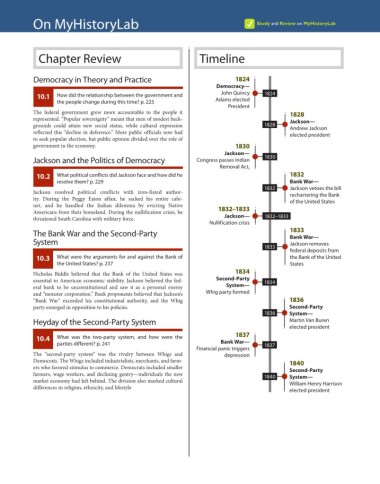Page 277 - American Stories, A History of the United States
P. 277
On MyHistorylab Study and Review on MyHistoryLab
Chapter Review Timeline
Democracy in Theory and Practice 1824
Democracy—
10.1 How did the relationship between the government and John Quincy 1824
the people change during this time? p. 225 Adams elected
President
The federal government grew more accountable to the people it 1828
represented. “Popular sovereignty” meant that men of modest back- Jackson—
grounds could attain new social status, while cultural expression 1828 Andrew Jackson
reflected this “decline in deference.” More public officials now had elected president
to seek popular election, but public opinion divided over the role of
government in the economy. 1830
Jackson—
Jackson and the Politics of Democracy Congress passes indian 1830
Removal Act,
10.2 What political conflicts did Jackson face and how did he 1832
resolve them? p. 229 Bank War—
1832 Jackson vetoes the bill
Jackson resolved political conflicts with iron-fisted author- rechartering the Bank
ity. During the Peggy Eaton affair, he sacked his entire cabi- of the United States
net, and he handled the Indian dilemma by evicting Native
Americans from their homeland. During the nullification crisis, he 1832–1833
threatened South Carolina with military force. Jackson— 1832–1833
Nullification crisis
The Bank War and the Second-Party 1833
Bank War—
System Jackson removes
1833
federal deposits from
10.3 What were the arguments for and against the Bank of the Bank of the United
the United States? p. 237 States
Nicholas Biddle believed that the Bank of the United States was 1834
essential to American economic stability. Jackson believed the fed- second-Party 1834
eral bank to be unconstitutional and saw it as a personal enemy system—
and “monster corporation.” Bank proponents believed that Jackson’s Whig party formed
“Bank War” exceeded his constitutional authority, and the Whig 1836
party emerged in opposition to his policies. second-Party
1836 system—
Heyday of the Second-Party System Martin van Buren
elected president
10.4 What was the two-party system, and how were the 1837
parties different? p. 241 Bank War— 1837
financial panic triggers
The “second-party system” was the rivalry between Whigs and depression
Democrats. The Whigs included industrialists, merchants, and farm- 1840
ers who favored stimulus to commerce. Democrats included smaller second-Party
farmers, wage workers, and declining gentry—individuals the new 1840 system—
market economy had left behind. The division also marked cultural William Henry Harrison
differences in religion, ethnicity, and lifestyle elected president

